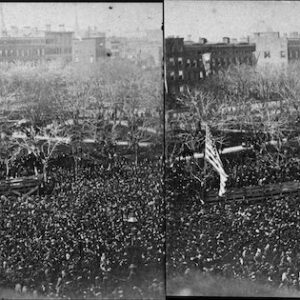Tag: Union Square (New York NY)
Wikipedia says: Union Square is a historic intersection and surrounding neighborhood in Manhattan, New York City, located where Broadway and the former Bowery Road – now Fourth Avenue – came together in the early 19th century. Its name denotes that “here was the union of the two principal thoroughfares of the island”. The current Union Square Park is bounded by 14th Street on the south, 17th Street on the north, and Union Square West and Union Square East to the west and east respectively. 17th Street links together Broadway and Park Avenue South on the north end of the park, while Union Square East connects Park Avenue South to Fourth Avenue and the continuation of Broadway on the park’s south side.
The area around present-day Union Square was initially farmland. The western part of the site was owned by Elias Brevoort, who later sold his land to John Smith in 1762; by 1788 it had been sold again to Henry Spingler (or Springler). On the eastern part of the land were farms owned by John Watts and Cornelius Williams. The northwestern corner of the park site contained 1 acre (0.40 ha) of land owned by the Manhattan Bank, which supposedly was a “refuge” for businesses during New York City’s yellow fever epidemics.
When John Randel was surveying the island in preparation for the Commissioners’ Plan of 1811, the Bloomingdale Road (now Broadway) angled away from the Bowery at an acute angle. Because it would have been difficult to develop buildings upon this angle, the Commissioners decided to form a square at the union. In 1815, by act of the state legislature, this former potter’s field became a public commons for the city, at first named Union Place. Union Place originally was supposed to extend from 10th to 17th Streets. Several city officials objected that Union Place was too large and requested that it be “discontinued”, and in 1814, the New York State Legislature acted to downsize the area by making 14th Street the southern boundary.
In 1831, at a time when the city was quickly expanding and the surrounding area was still sparsely developed, Samuel Ruggles, one of the founders of the Bank of Commerce and the developer of Gramercy Park to the northeast, convinced the city to rename the area as “Union Square”. In doing so, Ruggles also got the city to enlarge the commons to 17th Street on the north and extend the axis of University Place to form the square’s west side, thus turning the common from a triangular to a rectangular area. By 1832, the area had been renamed Union Square. Ruggles obtained a fifty-year lease on most of the surrounding lots from 15th to 19th Streets, where he built sidewalks and curbs. In 1834, he convinced the Board of Aldermen to enclose and grade the square, then sold most of his leases and in 1839 built a four-story house facing the east side of the Square. The park at Union Square was completed and opened in July 1839.
A fountain was built in the center of Union Square to receive water from the Croton Aqueduct, completed in October 1842. In 1845, as the square finally began to fill with affluent houses, $116,000 was spent in paving the surrounding streets and planting the square, in part owing to the continued encouragement of Ruggles. The sole survivors of this early phase, though they have been much adapted and rebuilt, are a series of three- and four-story brick rowhouses, 862–866 Broadway, at the turn where Broadway exits the square at 17th Street. The Everett House on the corner of 17th Street and Fourth Avenue (built 1848, demolished 1908) was for decades one of the city’s most fashionable hotels.
Showing the single result
